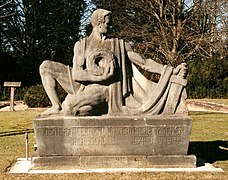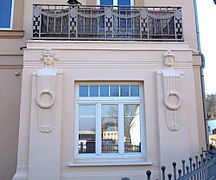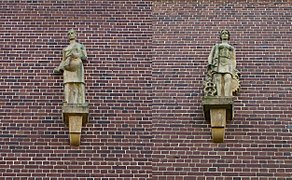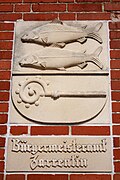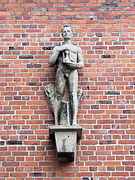Maximilian Preibisch
Maximilian Preibisch , also: Max Preibisch (born November 23, 1877 in Prasseditz , Bohemia ; † January 10, 1940 in Boizenburg / Elbe ) was a sculptor with Austrian citizenship who lived in Germany.
biography
Preibisch was born in the small Bohemian town of Prasseditz near the spa town of Teplitz . After attending the community school, she initially trained at the Teplitz technical school for ceramics and related arts and crafts. He then studied from 1901 to 1908 at the Academy of Fine Arts Vienna with Edmund Hellmer and Hans Bitterlich . Due to his artistic talent, Preibisch was able to attend the special class for higher sculpture led by Edmund Hellmer from 1904 to 1908. Hellmer's artistic preferences for monuments, tombs and allegorical figures influenced Preibisch's works throughout his life. After completing his studies, he left Austria to set up his first studio in Hamburg. In 1910 he met the talented young graphic artist Therese Preibisch-Lemm (born October 29, 1893 - April 24, 1972) on a trip to Boizenburg, whom he married in Bergedorf in 1913. Both ran a joint studio in Hamburg-Bergedorf , which the woman's wealthy father, owner of the F. Lemm shipyard in Boizenburg, financed until 1917. In 1915 Preibisch volunteered for military service in the Austrian Austro-Hungarian Army and served with the rank of lieutenant of the reserve at the headquarters of the Landwehr infantry regiment "Leitmeritz" No. 9 . Due to financial problems, the couple had to give up the spacious Bergedorf studio in 1917 and moved to the tranquil small town of Boizenburg . Here they founded the Boizenburger Kunstverein in 1923, which influenced the city's cultural life for many years. Preibisch initially had a studio in the house at Marktorstrasse No. 1, but later moved to the storage rooms of an office building at Reichenstrasse No. 17. There he created a remarkable number of plastic works of art. Maximilian Preibisch died of the consequences of a stroke that he had previously suffered while clearing his rowboat in the Boizenburg city harbor. He was buried in the grave chapel of the Lemm family in the Boizenburg cemetery.
Therese Preibisch-Lemm was also artistically active after the death of her husband. In 1949 she founded the Boizenburg / Elbe artist collective with other visual artists . In April 1959, she left the former GDR with her youngest daughter Ingrid (born July 30, 1929), who had studied sport in Greifswald , and moved to Lüdenscheid . The eldest daughter Ingeborg (born December 12, 1915) had fled the GDR in 1955 and left three of her eight children with her grandmother in Boizenburg. Therese Preibisch-Lemm died at the age of 79 in Lüdenscheid. It was like her husband in his parents' grave chapel in Boizenburg buried .
Act
Both Maximilian Preibisch and his wife did not succeed in developing a profitable artistic career in a difficult time for artists. Despite some remarkable sculptural works, which were mostly based on historicism and later on Art Nouveau , his work remained regionally limited. He also left numerous watercolors and colored pen and ink drawings , which he mainly sent to his friends. Preibisch also designed a shapely electric table lamp that depicted an almost unclothed female figure, in the style of Art Deco .
The artistic work of his wife Therese is largely unknown to this day and consists mainly of regional watercolors and pen drawings.
Selection of works
Plastic works
- Sculpture “Pain”, shown at the annual exhibition of the Academy of Fine Arts in Vienna in 1909
- Grave relief for Paul Georg Rolfs (1881–1917) in the Boizenburg cemetery, after 1918
- Two life-size busts resting on consoles on the home of the shipyard owner Lemm on Fährweg in Boizenburg
- War memorial with bronze medallion at the Zahrensdorf cemetery , inauguration October 19, 1920
- Commemorative plaque of the teachers and students of the Heinrich-Hertz-Realgymnasium Hamburg who died in 1914–18 , March 1921
- Memorial of the Groszheim'schen Realschule in Lübeck. It was unveiled on December 22, 1922 in the Ehrenfriedhof . Today it is in the Vorwerk cemetery .
- Tomb for Anton Pretschendörfer (1892–1923) in the Boizenburg cemetery, around 1923
- "Mother and Child", grave sculpture grave Louise Ziegert in the Boizenburg cemetery, from 1926
- War memorial 1914–18 on the Boizenburg cemetery, erected 1925/26
- War memorial 1914-18 in Kiel
- Frieze with allegories and symbolic figures on the Gustav Niemann residential and commercial building on the corner of Schloßstraße 32/34 / Mecklenburgstraße 41/43 in Schwerin, from 1928
- Animal reliefs on the home of the veterinarian Wilhelm Brumm, An der Quöbbe No. 20 in Boizenburg, from 1934
- Two fully plastic figures on consoles and four reliefs of the cities of Hagenow, Wittenburg, Boizenburg and Lübenheen above the entrance portal, former district office in Hagenstrasse in Hagenow, from 1928/29
- Coat of arms relief on the town hall of Zarrentin , from 1934
- Madonna sculpture for the Catholic Church at Bahnhofsstraße 53 in Boizenburg, from 1934
- Imperial eagle for the entrance gate of the NSDAP - Gauschule at Schloßgartenallee 61 in Schwerin, from 1935
- Six larger-than-life allegorical wall figures for the Hansa-Filmtheater in Maßmannstrasse in Rostock, from 1937
- Electroplating , male relief figure, manufactured in the Württemberg metal factory in Geislingen, from 1938
- Wall relief “Work in Boizenburg” in the reception hall of the train station (now a restaurant) of the Boizenburg city and port railway, Vor dem Mühlentor 14, from 1938
- Relief with allegorical figures on Otto Allmeling's house on Schwanheider Weg no.20 in Boizenburg, from 1938
Watercolors and pen drawings
- Watercolor at Färbergraben , Boizenburg Local History Museum, from 1924
- Pen drawing Die Kirche zu Zahrensdorf , Heimatmuseum Boizenburg, from 1934
Attributed works
- Bust of Georg Adolf Demmler in the Demmlerhof in Schwerin, around 1928
- Two masks , the tragedy and comedy performing, at the entrance of the light in the house Game Hagenstraße in Hagenow, 1938/39
- Design of the entrance area of the old tax office in Winsen / Luhe
- Design of four groups of figures for a “fairytale fountain”, which was to be exhibited on the occasion of the 1934 horticultural exhibition in Schwerin
- Medallion and flanking putti on the residential building on Hamburger Strasse No. 25 in Boizenburg
gallery
literature
- Knuth Wolfgramm (Ed.): Everyone is an artist (Beuys). 200 years of Boizenburg visual artists. Neuer Hochschulschriftenverlag, Rostock 1998, ISBN 978-3-929544-71-8 , p. 12 f.
- Volker Probst, Heidrun Lorenzen (Hrsg.): Fine arts in Mecklenburg and Pomerania from 1880 to 1950: Art processes between the center and the periphery. Hinstorff Verlag, ISBN 978-3-356-01406-8 , (Book accompanying the exhibition Pure Beauty. Mecklenburg - a country for artists 1900 to 1945 in Güstrow and Rostock 2010).
- Uwe Wieben: Maximilian Preibisch - a sculptor in Boizenburg. (Ed.): Boizenburger Museumsfreunde, Boizenburg 2011.
- Horst Ende : burial place and landscape park - the cemetery in Boizenburg. In: State Office for Culture and Monument Preservation (Ed.): Cultural heritage in Mecklenburg-Western Pomerania. Volume 4. Schwerin 2009, pp. 65-69.
- Uwe Wieben: Streiflichter from Boizenburg and the surrounding area: 51 historical miniatures. Leipziger Universitätsverlag, Leipzig 2016, ISBN 978-3-96023-002-1 , pp. 104–112.
Web links
Individual evidence
- ^ Josef Schermaier: Technical schools in Austria - Schools of skilled worker training: the technical schools for individual industrial branches. Peter Lang, Frankfurt am Main a. a. 2009, ISBN 978-3-631586-51-8 , pp. 84 ff.
- ↑ a b Uwe Wieben: Therese Preibisch Lemm. In: Boizenburger biographies. Neuer Hochschulschriftenverlag, Rostock 1998, ISBN 978-3-929544-42-8 , pp. 46–53.
- ↑ Uwe Wieben: Streiflichter from Boizenburg and the surrounding area: 51 historical miniatures. Leipziger Universitätsverlag, Leipzig 2016, ISBN 978-3-96023-002-1 , p. 107 f.
- ↑ a b Uwe Wieben: Streiflichter from Boizenburg and the surrounding area: 51 historical miniatures. Leipziger Universitätsverlag, Leipzig 2016, p. 146 f.
- ↑ Preibisch took part in the Academy's annual exhibition every year, and in the following years he showed the sculpture “Renunciation” cf. Uwe Wieben: Streiflichter from Boizenburg and the surrounding area: 51 historical miniatures. Leipziger Universitätsverlag, Leipzig 2016, p. 106.
- ↑ Uwe Wieben: People in Boizenburg: Their work in politics and culture, in handicrafts, in the shipyard and in the record factory in the late 19th and early 20th centuries. Akademische Verlagsanstalt Leipzig, Leipzig 2013, p. 83.
- ↑ a b Horst Ende: Burial place and landscape park - the cemetery in Boizenburg. In: State Office for Culture and Monument Preservation (Ed.): Cultural heritage in Mecklenburg-Western Pomerania. Volume 4. Schwerin 2009, p. 68.
- ↑ Burkhart Stender: Architect between two world wars. In: svz.de. July 15, 2016, accessed May 30, 2017 .
- ↑ Knuth Wolfgramm (ed.): Everyone is an artist (Beuys). 200 years of Boizenburg visual artists. Neuer Hochschulschriftenverlag, Rostock 1998, ISBN 978-3-929544-71-8 , p. 12 f.
- ↑ Preibisch chose among other things the Ludwigsluster Juchhans and the Bockuper Kuckuck, which come from the Mecklenburg world of legends. see. Richard Wossidlo: Mecklenburg sagas: a people's book. Volume 1. Hinstorff Verlag, Rostock 1939, pp. 122-133.
- ↑ a b Uwe Wieben: Streiflichter from Boizenburg and the surrounding area: 51 historical miniatures. Leipziger Universitätsverlag, Leipzig 2016, p. 110.
| personal data | |
|---|---|
| SURNAME | Preibisch, Maximilian |
| ALTERNATIVE NAMES | Preibisch, Max |
| BRIEF DESCRIPTION | Austrian sculptor |
| DATE OF BIRTH | November 23, 1877 |
| PLACE OF BIRTH | Prasseditz , Bohemia |
| DATE OF DEATH | January 10, 1940 |
| Place of death | Boizenburg / Elbe |
